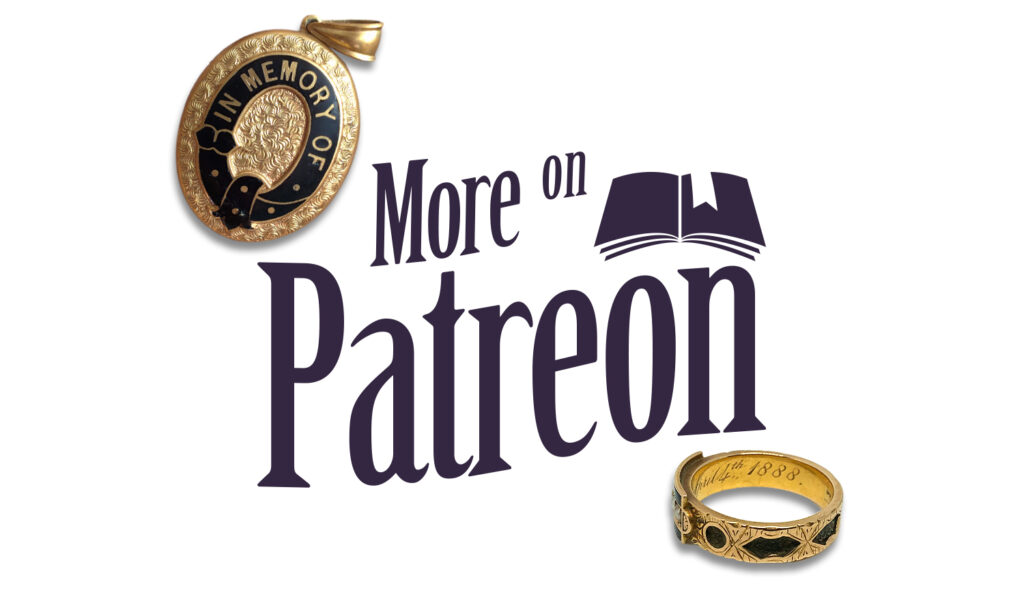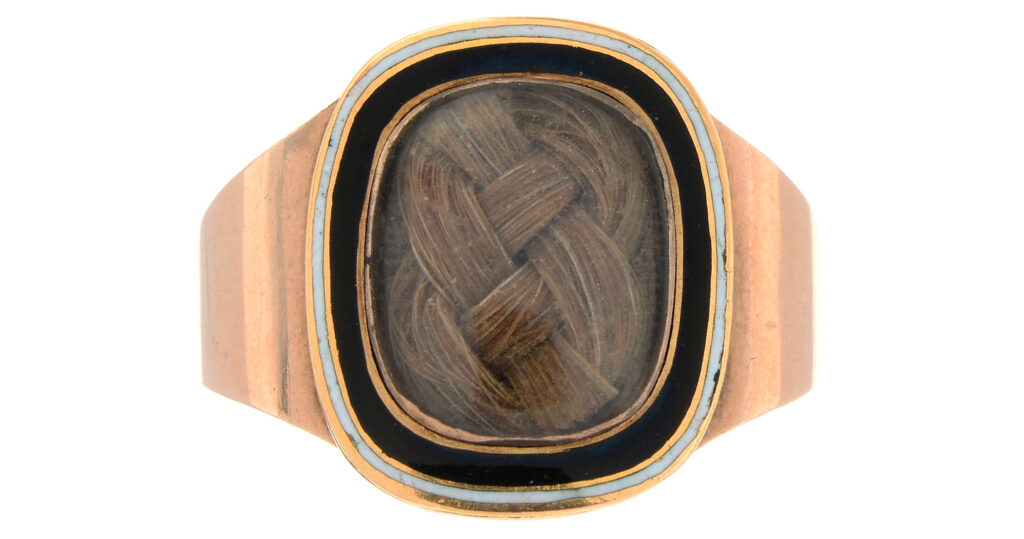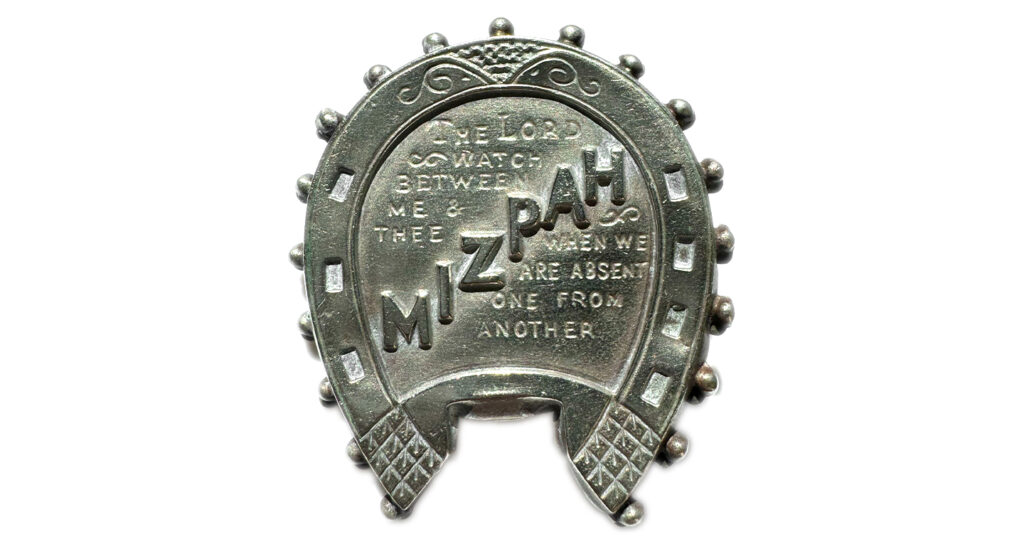Robert Alywin’s 1816 Swivel Mourning Ring and Society
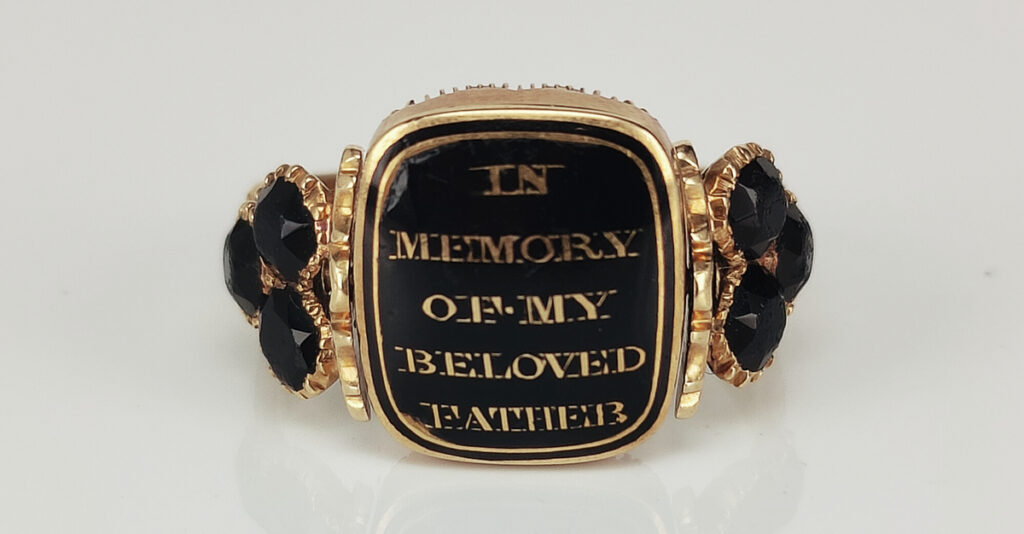
‘IN MEMORY OF’ captures the perfect sentiment for mourning jewels. At their very essence, they are created to stimulate the memory of a deceased family member or friend. Memory is important for the continuity and life of a person to exist long after they are gone. Stories that are passed down through generations keep the spirit alive. These stories and their messages are the germ of knowledge and experience that can benefit successive generations to grow from. If the mourning ring can educate people of the future, then the life of a person is used as a template for success.
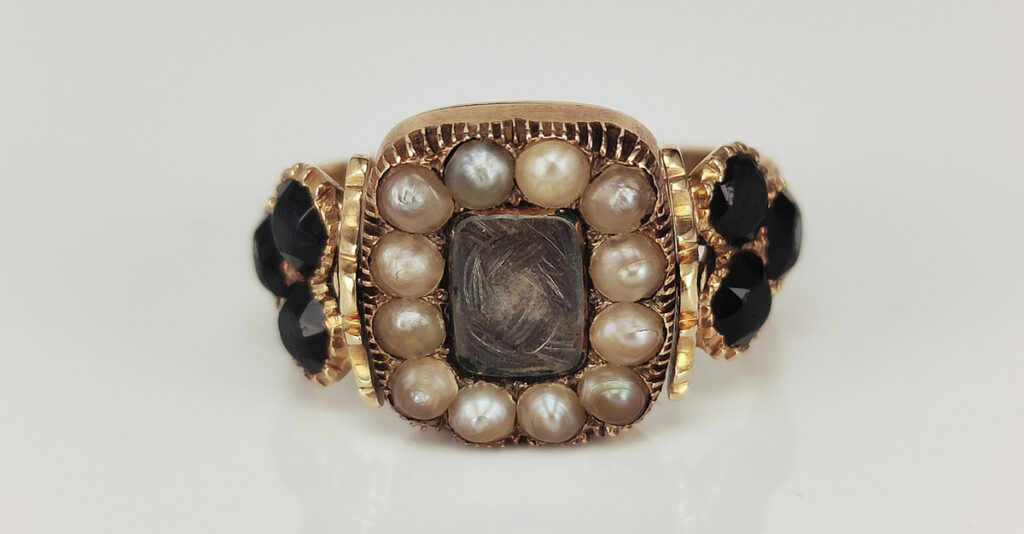
Mourning rings were produced in high volumes during the 17th to early 20th centuries. They were a cultural statement in society about wealth and respect for the dead, offering an insight into family structure and social values during these times. The cost of the rings were outlined in wills by the testator and their creation after the death was enabled by the executor of the will. This leads to many interesting design patterns in these jewels, which often conform to mainstream social fashions and the religious values of the family.

Protestant England during the 17th century was seeing new wealth in the guide of mercantilism and a new merchant class. Education was becoming more accessible, leading to a higher comprehension of the written word. Coffee houses, filled with gazettes and wealthy men became public areas were the wealthy could show their fashion in society. Venerating death with fashionable products and a custom of wearing/displaying them set a person of class apart from others, as they could afford these mourning products. Retailers, textile producers, jewellers and goldsmiths all capitalised on the demand for this fashion, leading to their success and economic stimulus. Mourning rings were important to promote Protestant values, as the symbols of death set society apart from Catholic Europe. Puritanical feeling in the early 17th century pushed for harder religious reform to remove all the trappings of the Catholic Church that remained in the Church of England, making the essential symbols of death far more important than any religious figure or icon. The skull, crossbones and hourglass were all stark reminders of living a better, more educated and successful life to improve the values of the family and then receive final judgement for your life well lived.
By the 18th century, this gifting custom had been engrained in society and by the 19th, it was reaching the middle classes. When Robert Patrick Alywin died on the 24th of May, 1816, at the age of 54, this ring creates a grand, personal statement for his children.

‘IN MEMORY OF MY BELOVED FATHER’ is a curious message for the child to display. The ring’s design elegantly allows the wearer to swivel this into the finger and display the hair more prominently, with its pearl surround. Personal statements of love began evolving into the standard ‘IN MEMORY OF’ or ‘IN MEMORIAM’ design that would be the iconic statement for Victorian mourning jewels of the latter 19th century. During the c.1810 – c.1830 period, there was a push back to Medieval values through architecture and art, a reaction to the Industrial Revolution, the rise of populated cities and the automation of craft. This was reflected in religious values, such as the Oxford Movement, where members, along with members of the High Church of the Church of England, tried to reinstate Catholic liturgy and theology back into practice. There was a strong feeling that the Church of England lacked the ceremony and morality of the Roman Catholic Church, so a series of publications, the “Tracts of the Times”, was published. It comprised of 90 documents of various length offering reasons why morality had slipped and why this religious value was necessary for England.

Family values were an important political topic in the early 19th century, as this ring was produced at a time following the Napoleonic Wars, which was a reminder of what could happen in the Libertarian movement encouraged a revolution. Having conformity and ritual behaviour in society was important for British unity. Fashion and art are perfect conveyances for this, as any behaviour outside of the social normal can be deemed unsavoury. Mourning custom and respect is perfect for this, as anything less is seen as disrespectful for a family. Its cascading economic effect to benefit crafts people and businesses only built the British economy. If these jewels were worn locally or internationally, it was a proud reminder of British nationalism, even in Catholic countries.
No other symbol can be more powerful for the Britons than the Crown. A primary figurehead who controls the direction of the nation, which had a legitimate global reach in the 18th century. Naval strength and power were intrinsic to the identity of the British during this time, which was increasingly politically unstable throughout Europe and the Americas. George III’s ailments represent the nation’s burden, not only his own. Since the death of Princess Amelia in 1810, his mental health declined, which was at a time of the Napoleonic Wars. This was a time where the British needed strength and solidarity, something which was found within the military figures, such as Horatio Nelson and Arthur Wellesley, 1st Duke of Wellington. Victories on the land and sea had a positive uplift in public confidence and national identity.
Symbols that were utilised for the death of Princess Amelia utilised what was popular and understood from a national level.
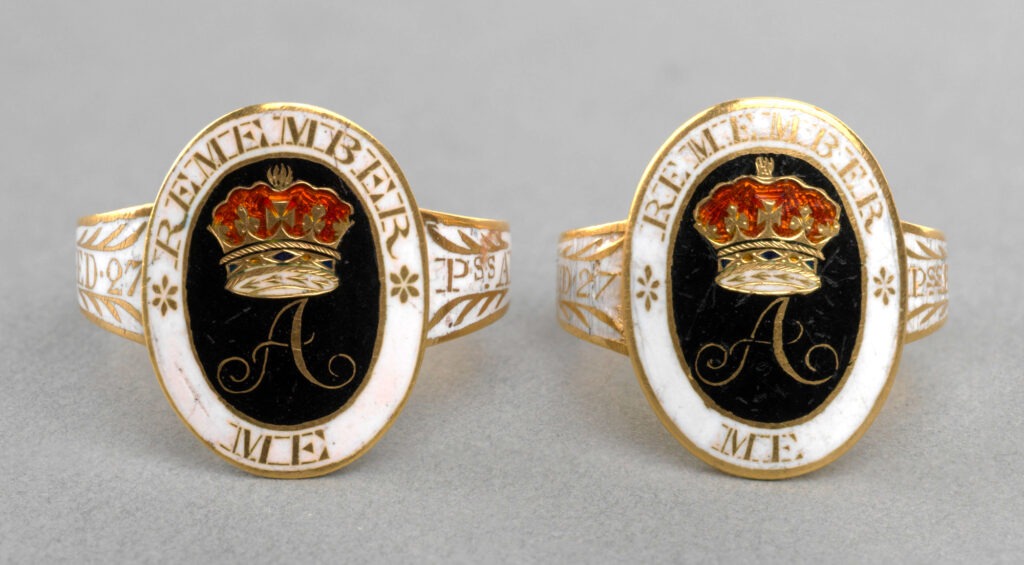
Amelia’s death in 1810 produced a number of mourning products, from jewellery to medals. The symbols used for her death are a combination of the most important identifiers of classical death, as well as very natural depictions of Amelia. Her mourning jewels show the highest level of quality for her death and the message of ‘REMEMBER ME’ was used for a variety of jewels made for friends and family.
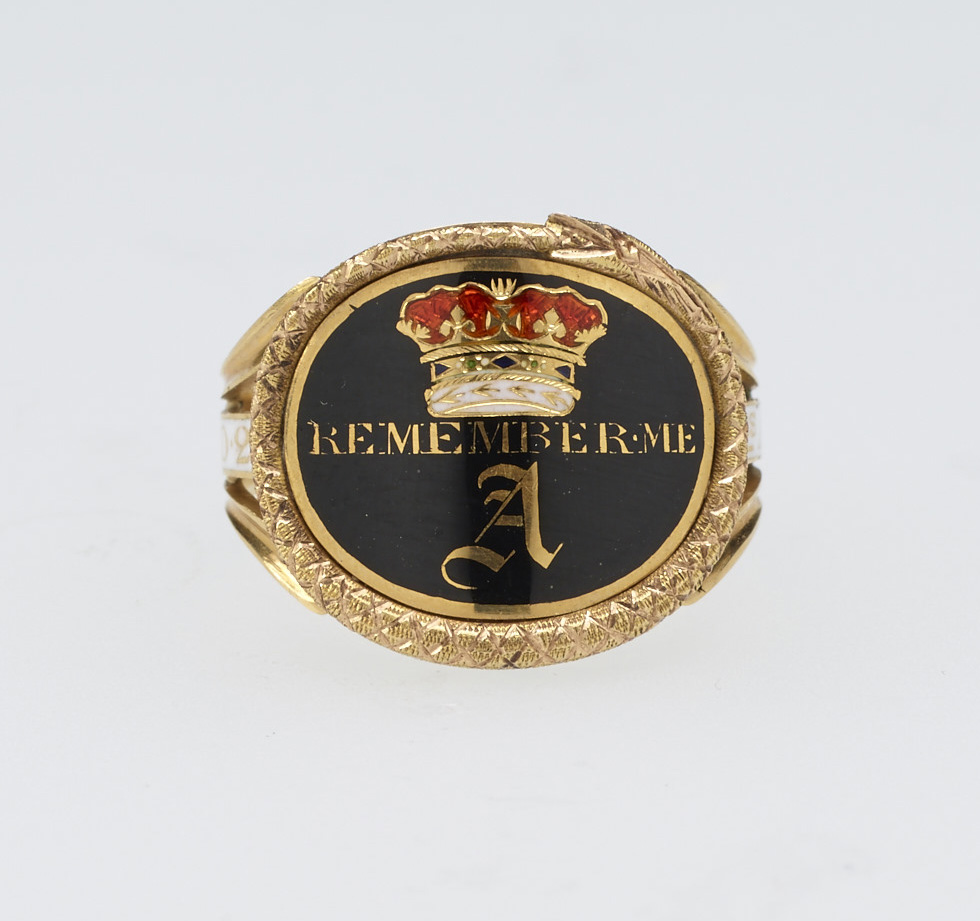
Mourning jewellery messages had been tailored in the painted sepia-toned jewels of the Neoclassical c.1760 – c.1800 period, which was often painted as per the commission of the family. Personal messages actually designed into the gold of the ring had been predominantly for mourning bands, which had the name and date of death. During the c.1810 period, ‘IN MEMORY OF’ grew as the standard message designed into the ring itself. For Alywin’s ring, the early development of this message can be seen for his ‘dearest father’.
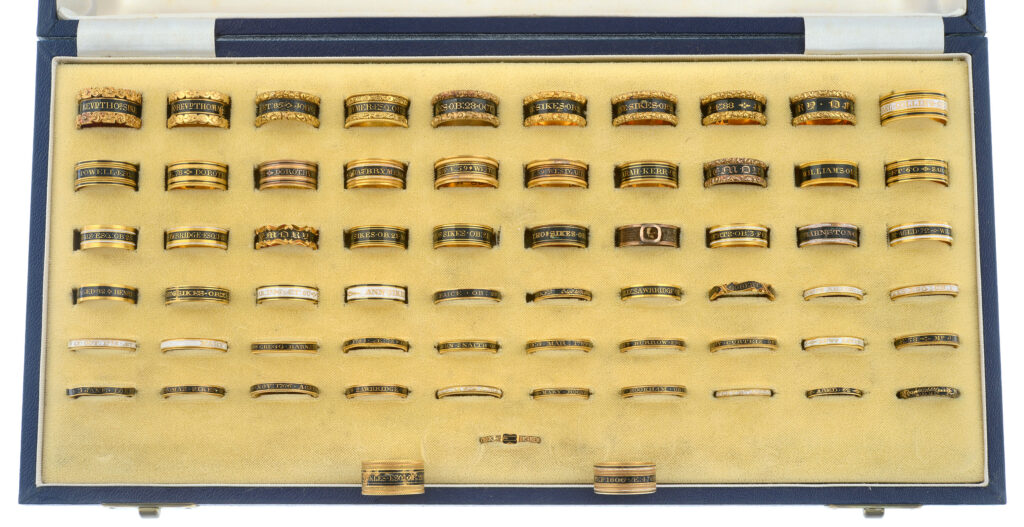
The collection of rings above shows the standardisation of mourning rings for three generations of family members during the c.1710 – c.1840 period. These rings were produced in volume and given out at funerals, which is where there are often several variations of the same ring.
‘IN MEMORY OF’ has its values in the bible, which aligns well with the social move back to Medieval times and regaining the chivalric code. As its use became more and more consistent in jewellery designs of this period, Queen Victoria’s own tragedy upon the death of Prince Albert in 1861 only cemented the use of the sentiment in jewellery design, making it consistent for the rest of the century.

Memory, piety, respect and the promise of reward in the afterlife are all important factors of having the mourning ring as a keepsake. They often were only worn at special events, as many held onto them as a memorial token. The connection of the message to the bible can be seen in the institution of the Eucharist:
and when He had given thanks, He broke it and said, “This is My body, which is for you; do this in remembrance of Me.”
1 Corinthians 11:24
Amelia’s ‘REMEMBER ME’ and the subsequent popularity of ‘do this in remembrance of me’ shorted to become ‘in memory of’. It is a pure message of all the values that a family needed in a society governed by the Church of England, whose Monarch is the Supreme Governor.

Robert Patrick Alywin is remembered through his family in this ring, which also reflects the values of British society at this time. All these factors would influence the future Queen Victoria and establish what a ‘good’ Christian family needed to be in Victorian society. Many of these values and social structure exist today. It is remarkable at how one, small, historical fashion artefact can encapsulate so much meaning in its design.




